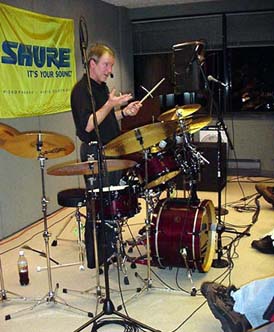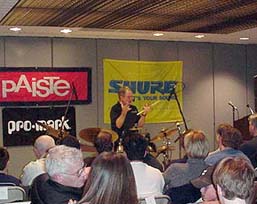Welcome to PaulWertico.com!
Clinic & Masterclass Topics:
All or most the following topics will be discussed and demonstrated by Paul in an order that fits each individual clinic & masterclass situation. Please feel free to ask questions about any of the topics that are of particular interest to you.

Hand Methods & Techniques:
- matched grip vs. traditional grip
- placement of hands on sticks
- the fulcrum & finger placement
- shoulder relaxation & elbow placement
- the Free Stroke
- the Moeller Method
- the Adler Stroke
- the Poing Stroke
- the circle of gravity & using the correct height hand position
- using gravity & a follow-through
- tight grip vs. loose grip
- up & down stroke vs. side to side stroke
- the drop-catch technique
- playing into the drum & off the drum
- velocity = volume, pitch & energy
- be aware of articulation at different dynamic levels
- listening to your sound, not just imagining it
- listening for evenness in strokes
- even bounces vs. uneven bounces
- catching the bounce
- playing on pillows, etc.
- placement of sticks on drum head and when to move them around
- using overtones
- using dead strokes
- unique strokes
- stickings within stickings
- strengthening and stretching exercises
- crumbling newspaper exercise
- keeping a phone book under each underarm
- creative use of Rudiments
- placing rhythms & Rudiments into polyrhythms
- warming up
- getting notes using both the up stroke & the down stroke
- snare drum height & angle
Bass Drum Methods & Techniques:
- heel down vs. heel up vs. full leg vs. rocking motion vs. side to side
- combining heel up and heel down
- rolling the heal up and burying the beater exercises
- your drum seat height
- your pedals' tension & beater angle
Hi-Hat Methods & Techniques:
- heel down vs. rocking motion vs. bouncing motion vs. side to side
- strengthening and stretching exercises
- hi-hat cymbals' height & angle
- hi-hat cymbals' spacing
- making the hi-hat jazz ride pattern "swing"
Time:
- playing from the "inside out"
- internalizing your pulse
- using a metronome
- imagining an invisible grid (whole note, half notes, quarter notes, eighth notes, sixteenth notes, quarter note triplets, double time, etc.)
- building off the quarter note
- subdividing
- feeling the space between notes
- visualizing up for upbeats and down for downbeats
- giving full value to all strokes, big and small
- giving full value to all rests, big and small
- skeletal rhythms
- thinking slow when playing fast & vice versa
- feeling centered
- staying inside yourself & not getting too scattered
- the importance of breathing correctly
- holding your own & not getting distracted
- building up momentum
- limb coordination and how the time is effected
- limb fighting limb
- dynamics & evenness
- elastic vs. solid vs. click track vs. sequencers
- distance & accuracy
- playing with good players
- playing with the bass, the melody, the soloist
- time vs. feel
Feel:
- consistency of sound
- basic volume & accents
- where you hit the drum head, etc.
- placement of beat
- delayed backbeat
- posture
- playing from the bottom up & vice versa
- little adjustments can make a big difference
- how coordination can affect feel
- relaxed vs. tense - tight vs. loose
- keeping it vital
- staying inside the music
- keeping musical headroom by staying just under your maximum capabilities
- tension & release
- the "four" feel vs. the "two" feel
- circular motion vs. up & down
- the right dance for the right groove
- funky & earthy vs. overly bookish & calculated
- authentic vs. new interpretation
- playing "frontbeats" instead of "backbeats"
- playing open-handed
Playing Fills:
- the purpose of the fill
- making it fit
- keeping in the style
- keeping a flow
- starting and finishing a phrase
- staying in the moment
- not getting ahead of yourself
- making the fill part of the groove
- keeping the backbeat in focus
- not rushing the previous beats
- keeping beat "1" in place
- thinking into beat "2" etc.
- using skeletal rhythms
- using repetition
- playing over the bar line
- anchoring points
Playing Cymbals:
- why certain cymbals are good for certain situations
- different sticks for different sounds
- building on the quarter note & the basic jazz ride pattern
- breaking up the time
- the in & out elbow method
- direct & side strokes
- double flat rides
- making the hands talk to each other
- moving your hands around the cymbal for different shades
- dynamics within the phrase
- the "Drone"
- the "Gush"
- the dead stroke (with extended forefinger)
- when to and when not to change cymbals
- crashing on beat "1" and other options
- swinging quarter notes using counterclockwise and clockwise circular motions by breaking up a open double stroke roll
- "dancing" on the cymbals using painting-type strokes and sword fighting motions
Playing Brushes:
- thinking in terms of grace and beauty
- different strokes - different tempos
- what part of the brush for light or heavy playing
- the left hand (how it moves in rhythm and when not to move it)
- evenness of double strokes
- my side swish
- unique strokes
- tap dancing and sand dancing influences

Making Music:
- your part in the overall picture
- knowing the song's form
- composing a part
- telling a story
- the drums as a translator of your ideas
- disappearing into the music
- when to lead and when to follow
- playing the music vs. playing the style
- taking chances
Developing A Fluid Sound:
- shaping your phrases using accents, dynamics, colors, etc.
- "Dynamics Within The Phrase"
- don't crash on beat "1" too much, so your playing doesn't sound too compartmentalized
- "hear" yourself "inside" and part of the overall music, instead of listening to yourself "on top of" the music
- let the music "play" you
- don't get too ahead of (or behind) the bass player, since the drums and bass should ground the music
- make the groove as "wide" as possible by really "playing" each note, don't pull your punches
- find the right stroke length for each tempo
- shape your sound by sculpting your sound using different strokes
- be aware of the end of each note, as well as the beginning
- treat silence as an equal partner by not feeling like you always have to play something
- give rests their full value
- get in and out of the music gracefully
- relax your shoulders and arms (and legs) so that they're able to move around more freely
- get into "the dance" of the tempo and music
- think and visualize sounding like a waterfall, where all sounds naturally fall into place, nothing is forced
Soloing:
- determining the purpose of the solo (song intro, groove solo, playing over the musical form, etc.)
- freeform vs. playing off the melody
- earthy vs. technical vs. flashy vs. the wildman
- playing & developing an idea
- using a "clave" pattern
- theme & development
- using repetition and tension & release
- utilizing dynamics
- utilizing space
- using all parts and areas of the kit (drum heads, cymbals, rims, shells, etc.)
- using drama
- using humor
- utilizing different sounds and instruments
- using mathematics when trading 4s, 8s, etc.
- using different "home bases" (snare drum, small tom, hi-hat, etc.)
Your Goals:
- why do we play?
- what do we want out of this?
- your level of commitment
- know yourself
- reality vs. dreams
- being ready when opportunity calls
- "jack of all trades, master of none" vs. mastering one style
- your reading ability
- your memory & musical comprehension level
- live vs. studio
- the way you look vs. the way you sound
- your private life
- branching out (producing, programming, engineering, teaching, etc.)
- business smarts
- keeping on top of changing times
- enjoying the process of "getting there"
Developing A Personality On Your Instrument:
- being true to yourself
- wild vs. reserved
- your reflexes and your body mass
- you are what you listen to
- you are what you can & can't play
- being able to keep your personality in different circumstances
- imitating vs. interpreting your favorite players' styles
- how you look when you play
- dealing with musical typecasting
Choosing Equipment:
- having the right sound for the job
- drums, cymbals, heads, sticks, etc.
- using unusual & found sounds